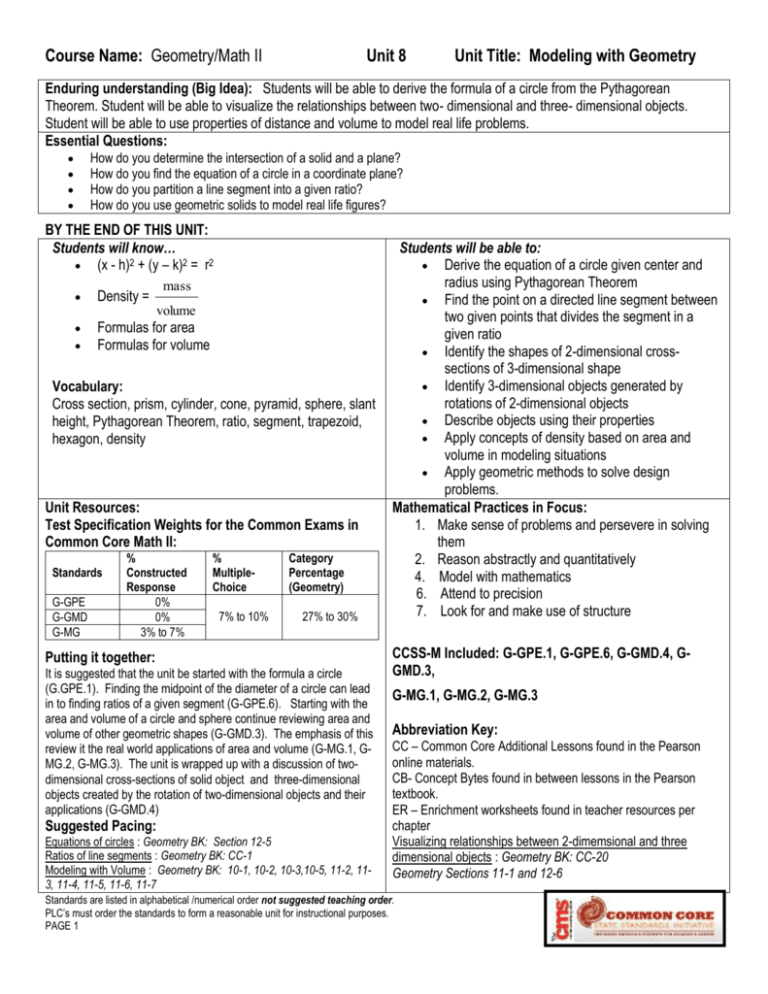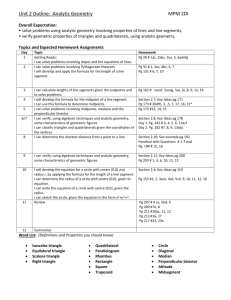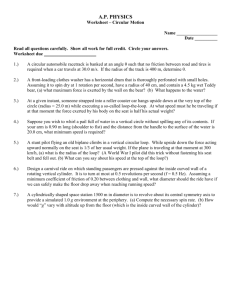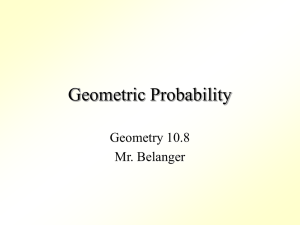MATH II Unit 8 MODELING WITH GEOMETRY
advertisement

Course Name: Geometry/Math II Unit 8 Unit Title: Modeling with Geometry Enduring understanding (Big Idea): Students will be able to derive the formula of a circle from the Pythagorean Theorem. Student will be able to visualize the relationships between two- dimensional and three- dimensional objects. Student will be able to use properties of distance and volume to model real life problems. Essential Questions: How do you determine the intersection of a solid and a plane? How do you find the equation of a circle in a coordinate plane? How do you partition a line segment into a given ratio? How do you use geometric solids to model real life figures? BY THE END OF THIS UNIT: Students will know… (x - h)2 + (y – k)2 = r2 Density = mass volume Formulas for area Formulas for volume Vocabulary: Cross section, prism, cylinder, cone, pyramid, sphere, slant height, Pythagorean Theorem, ratio, segment, trapezoid, hexagon, density Unit Resources: Test Specification Weights for the Common Exams in Common Core Math II: Standards G-GPE G-GMD G-MG % Constructed Response 0% 0% 3% to 7% % MultipleChoice 7% to 10% Category Percentage (Geometry) 27% to 30% Putting it together: It is suggested that the unit be started with the formula a circle (G.GPE.1). Finding the midpoint of the diameter of a circle can lead in to finding ratios of a given segment (G-GPE.6). Starting with the area and volume of a circle and sphere continue reviewing area and volume of other geometric shapes (G-GMD.3). The emphasis of this review it the real world applications of area and volume (G-MG.1, GMG.2, G-MG.3). The unit is wrapped up with a discussion of twodimensional cross-sections of solid object and three-dimensional objects created by the rotation of two-dimensional objects and their applications (G-GMD.4) Suggested Pacing: Equations of circles : Geometry BK: Section 12-5 Ratios of line segments : Geometry BK: CC-1 Modeling with Volume : Geometry BK: 10-1, 10-2, 10-3,10-5, 11-2, 113, 11-4, 11-5, 11-6, 11-7 Students will be able to: Derive the equation of a circle given center and radius using Pythagorean Theorem Find the point on a directed line segment between two given points that divides the segment in a given ratio Identify the shapes of 2-dimensional crosssections of 3-dimensional shape Identify 3-dimensional objects generated by rotations of 2-dimensional objects Describe objects using their properties Apply concepts of density based on area and volume in modeling situations Apply geometric methods to solve design problems. Mathematical Practices in Focus: 1. Make sense of problems and persevere in solving them 2. Reason abstractly and quantitatively 4. Model with mathematics 6. Attend to precision 7. Look for and make use of structure CCSS-M Included: G-GPE.1, G-GPE.6, G-GMD.4, GGMD.3, G-MG.1, G-MG.2, G-MG.3 Abbreviation Key: CC – Common Core Additional Lessons found in the Pearson online materials. CB- Concept Bytes found in between lessons in the Pearson textbook. ER – Enrichment worksheets found in teacher resources per chapter Visualizing relationships between 2-dimemsional and three dimensional objects : Geometry BK: CC-20 Geometry Sections 11-1 and 12-6 Standards are listed in alphabetical /numerical order not suggested teaching order. PLC’s must order the standards to form a reasonable unit for instructional purposes. PAGE 1 Course Name: Geometry/Math II Unit 8 Unit Title: Modeling with Geometry CORE CONTENT Cluster Title: Translate between the geometric description and the equation of a conic section Standard: G.GPE.1 Derive the equation of a circle given a center and radius using the Pythagorean Theorem: complete the square to find the center and radius of a circle given by an equation. Concepts and Skills to Master: Write the equation of a circle and apply it given a graph or a circle’s center and radius. Find the center and radius of a circle using the coordinate plane or the general form of the equation of a circle. SUPPORTS FOR TEACHERS Critical Background Knowledge: Distance Formula Sketching graphs on a coordinate plane (x-y axis). Academic Vocabulary: standard form of an equation of a circle, center of a circle on the coordinate plane (h, k), radius (r) Suggested Instructional Strategies: Starting Resources: Arrange students into pairs of mixed abilities. Equation of Circle Interactive Applet On the board, draw a circle on a coordinate http://www.mathwarehouse.com/geometry/circle/equationplane. One student will write an equation of the of-a-circle.php circle using the center and the radius, and the Equations of Circles Powerpoint other student will use the center and one point. (Including Completing the Square) Tell them to share their equations and discuss www.mathxtc.com/Downloads/MeasureGeo/files/Circles.ppt any discrepancies. You may vary this activity Online Teacher Resource Center by having one student draw a circle on a www.pearsonsuccessnet.com- Geometry coordinate plane and the other write the Dynamic Activity 12-5: Circles in the Coordinate Plane equation. The drawings can be done on graph Completing the square is not covered in the Pearson paper in a page protector so that the paper can Geometry text. However, online resources from be cleaned and reused. Chapter 10 of the Pearson Algebra 2 text can be used Emphasize that writing the equation for a circle as a resource to teach or review completing the square. in standard form makes it easier to identify the www.pearsonsuccessnet.com - Algebra 2 p.633 – center (h, k). Problem 4 http://www.shmoop.com/common-core-standards/ccssRemind students to take the square root of the value r2 hs-g-gpe-6.html in order to find the radius. Sample Assessment Tasks Skill-based task: Problem Task: What is the standard equation of each circle? 1. Suppose you know the center of a circle and a point on the 1. center(2,3);radius = 5 circle. How do you determine the equation of the circle? 2. center(0,1);radius = 7 2. A student says that the center of a circle with equation: What is the center and radius of each circle? (x – 2)2 + (y + 3)2 = 16 is (-2, 3). What is the student’s error? How should the equation read in order to make the student 3. (x4)2+(y–3)3 = 16 4. (x+7)2+y2 = 10 correct? Teacher Created Argumentation Task (W1-MP3&6) THINK ABOUT A PLAN: Find the circumference and area of the circle whose equation is (x – 9)2 + (y – 3)2 = 64. Leave your answers in terms of pi. Include in your answer the following: What essential information do you need? What formulas will you use? (Taken from PH Geometry, p.802 #44) Standards are listed in alphabetical /numerical order not suggested teaching order. PLC’s must order the standards to form a reasonable unit for instructional purposes. PAGE 2 Course Name: Geometry/Math II Unit 8 Unit Title: Modeling with Geometry CORE CONTENT Cluster Title: Translate between the geometric description and the equation of a conic section Standard: G-GPE.6 Find the point on a directed line segment between two given points that partitions the segment in a given ratio Concepts and Skills to Master: Use coordinate geometry to divide a segment into a given ratio Determine the midpoint of a segment given two endpoints Determine the endpoint of a segment given a midpoint and one endpoint SUPPORTS FOR TEACHERS Critical Background Knowledge: solving equations, distance formula Academic Vocabulary: Coordinates, a:b ratio, directed line segment, midpoint, endpoint Suggested Instructional Strategies: Starting Resources: Geometry Textbook Correlation: CC-1 After using the midpoint formula to find the midpoint of the http://www.shmoop.com/common-core-standards/ccss-hs-gdiameter of a circle, lead in to finding other ratios of a line gpe-6.html segment. Sample Assessment Tasks Skill-based task: Problem Task: A segment with endpoints A(3,2) and B(6,11) is partitioned A point B(4, 2) on a segment with endpoints A(2, -1) and by a point C such that AC and CB form a 2:1 ratio. Find C. C(x, y) partitions the segment in a 1:3 ratio. Find x and y. If general points N at (a,b) and P at (c,d) are given. Why are the coordinates of point Q (a,d)? Can you find the coordinates of point M? If you are given the midpoint of a segment and one endpoint. Find the other endpoint. a. midpoint: (6, 2) endpoint: (1, 3) b. midpoint: (-1, -2) endpoint: (3.5, -7) If Jennifer and Jane are best friends. They placed a map of their town on a coordinate grid and found the point at which each of their house lies. If Jennifer’s house lies at (9, 7) and Jane’s house is at (15, 9) and they wanted to meet in the middle, what are the coordinates of the place they should meet? Standards are listed in alphabetical /numerical order not suggested teaching order. PLC’s must order the standards to form a reasonable unit for instructional purposes. PAGE 3 Course Name: Geometry/Math II Unit 8 Unit Title: Modeling with Geometry CORE CONTENT Cluster Title: Visualize relationships between two-dimensional and three- dimensional objects Standard: G-GMD.4 Identify the shapes of two-dimensional cross sections of three-dimensional objects, and identify threedimensional objects generated by rotations of two-dimensional objects. Concepts and Skills to Master: Identify the shapes of two-dimensional cross-sections of three-dimensional objects Identify three-dimensional objects generated by rotations of two-dimensional shapes SUPPORTS FOR TEACHERS Critical Background Knowledge: Recognize basic two-dimensional shapes Recognize basic three- dimensional shapes Academic Vocabulary: Cross section, square, circle, concentric circles, trapezoid, rectangle, sphere, rectangular, prism, cone, cylinder Suggested Instructional Strategies: Starting Resources: Geometry Textbook Correlation: CC-20 Geometry Chapter 11-1, 12-6 Have students tape cut-out to a straw, spin the Enrichment Activity 11-3 straw and describe the three-dimensional shape Geometry pg 706 problems 33-36 created Geometry pg 731 problems 33-36 Students can slice objects shaped in clay to http://www.shmoop.com/common-corediscover the cross-section standards/handouts/g-gmd_worksheet_4.pdf Sample Assessment Tasks Skill-based task: Problem Task: A circle has a radius of 15cm. What is the volume of the sphere made by rotating this circle? Given a cylinder with radius 7 in and height 10 in, find the area of a cross section that is parallel to its base. Standards are listed in alphabetical /numerical order not suggested teaching order. PLC’s must order the standards to form a reasonable unit for instructional purposes. PAGE 4 Given a cylinder with height 60mm and radius 20mm, find the area of the rectangle formed by a perpendicular cross-section right down the cylinder’s center. If an equilateral triangle with perimeter 24 cm is rotated, find the volume of the cone that is formed. Course Name: Geometry/Math II Unit 8 Unit Title: Modeling with Geometry CORE CONTENT Cluster Title: Geometric Measurement and Dimensions Standard: G-GMD.3 – Use volume formulas for cylinders, pyramids, cones, and spheres to solve problems. Concepts and Skills to Master: Find the volume of cylinders, pyramids, cones, and spheres in contextual problems. SUPPORTS FOR TEACHERS Critical Background Knowledge: Formulas for the volumes of cones, cylinders, and spheres (8.G.9). Academic Vocabulary: pyramid, cylinder, cone, sphere, volume, length, width, height, base, radius, π. Suggested Instructional Strategies: Starting Resources: Have students bring household objects with the Geometry Textbook Correlation: Pearson Chapter 11.2, 3, given characteristics. Provide opportunities for 4, 5, 6 students to measure with rulers or tape measures to gather needed information. Compute the volume of http://www.shmoop.com/common-core-standards/ccss-hs-gthe objects. gmd-3.html Make connections between metric measurements. (For example, using rice to fill a cylinder compare the liquid volume in liters and the geometric volume in cubic meters.) Sample Assessment Tasks Skill-based task: Problem Task: Find the volume of a cylindrical oatmeal box Calculate the volume of helium needed to inflate a spherical latex balloon with a diameter of 18 inches. Given a cube with an edge of 8in and a sphere with a diameter of 8 in. calculate the volume remaining in the cube if the sphere in inserted into the cube. Standards are listed in alphabetical /numerical order not suggested teaching order. PLC’s must order the standards to form a reasonable unit for instructional purposes. PAGE 5 Given a three-dimensional object, compute the effect on volume of doubling or tripling one or more dimension(s). (For example, how is the volume of a cone affected by doubling the height?) A cone is enclosed inside a cylinder. The cone and the cylinder have equal bases and equal heights. If the volume of the cone is 30 cm3, what is the volume of the cylinder Course Name: Geometry/Math II Unit 8 Unit Title: Modeling with Geometry CORE CONTENT Cluster Title: Apply geometric concepts in modeling situations Standard: G-MG.1 Use Geometric shapes, their measures and their properties to describe objects (e.g modeling a tree trunk or a human torso as a cylinder) This is a Math I topic. It is being reviewed to support Standards G-MG.1, G-MG.2 and G-MG.3 Concepts and Skills to Master: Use geometric shapes, their measures, and properties to describe objects SUPPORTS FOR TEACHERS Critical Background Knowledge: Formulas for area and volume Names and properties of geometric shapes Academic Vocabulary: Circle, rectangle parallelogram, trapezoid, hexagon, triangle, prism, cone, cylinder, pyramid Suggested Instructional Strategies: Resources: Geometry Textbook Correlation: 10-1, 10-2, 10-3, 10-4 During the review of area and volume of geometric objects 11-3, 11-4, 11-5, 11-6, and 11-7 the emphasis should be placed on the modeling and using http://www.shmoop.com/common-core-standards/ccss-hs-gthese properties to solve real life problems. mg-1.html Sample Assessment Tasks Skill-based task: Problem Task: Consider a rectangular swimming pool 30 feet long and 20 feet wide. The shallow end is 3½ feet deep and A fountain takes the shape of a half sphere with extends for 5 feet. Then for 15 feet (horizontally) there is a diameter 10 feet that sits, flat side down, in the center of a round brick-paved patio of diameter 100 constant slope downwards to the 10 foot-deep end. feet. What is the area of the portion of the patio that a. Sketch the pool and indicate all measures on the sketch. b. How much water is needed to fill the pool to the top? To a is left uncovered? level 6 inches below the top? c. One gallon of pool paint covers approximately 75 sq feet Explanation: of surface. How many gallons of paint are needed to paint the inside walls of the pool? If the pool paint comes The area of the entire patio is 2500π square feet, 2 2 in 5-gallon cans, how many cans are needed? since A = πr = π(50) = 2500π. The base of the d. How much material is needed to make a rectangular pool fountain has an area of 25π square feet, since, 2 2 cover that extends 2 feet beyond the pool on all sides? again, A = πr = π(5) . The portion left uncovered will be the difference of the two numbers, or 2500π e. How many 6-inch square ceramic tiles are needed to tile the top 18 inches of the inside faces of the pool? If the – 25π = 2475π square feet. lowest line of tiles is to be in a contrasting color, how many of each tile are needed? Standards are listed in alphabetical /numerical order not suggested teaching order. PLC’s must order the standards to form a reasonable unit for instructional purposes. PAGE 6 Course Name: Geometry/Math II Unit 8 Unit Title: Modeling with Geometry CORE CONTENT Cluster Title: Apply geometric concepts in modeling situations Standard: G.MG.2- Apply concepts of density based on area and volume in modeling situations (e.g. persons per square mile, BTU’s per cubic foot) Concepts and Skills to Master: Students will be able to use the concept of density when referring to situations involving area and volume models. SUPPORTS FOR TEACHERS Critical Background Knowledge: Areas of Rectangles, Parallelograms, Circles, Triangles, Rhombuses, Kites, and Trapezoids Ability to choose the correct formula, substitute in values, and solve. Academic Vocabulary: Density, volume, modeling Suggested Instructional Strategies: Resources: When covering area you can discuss population Geometry Textbook Correlation: Pearson Chapter 11.2, 3, 4, 5, 6 density http://www.shmoop.com/common-core-standards/ccss-hs-g-mg When covering volume you can discuss density of 2.html Pearson Additional Problems m solid objects d v Sample Assessment Tasks Skill-based task: Problem Task: • A hot air balloon holds 74,000 cubic meters of helium, a very noble gas with the density of 0.1785 kilograms per cubic meter. How many kilograms of helium does the balloon contain? Explanation: Density is calculated as , or mass divided by volume. Fill in the two parts we know and solve for m = Vd = 74,000 m3 × 0.1785 kg⁄m3 = 13,209 kg. • The Mom & Pop Coffee Shop wants to open new locations, either downtown or uptown. They will open a new location wherever the ratio of existing coffee shops per person is less than 0.01. The population density of the 20-city-block downtown area is 225 people per city block, but there are already 48 coffee shops in the area. The population of the 30-block uptown area is 125 people per block, and there are 16 coffee shops around. Where, if anywhere, should they open their new location(s)? Explanation: (A) Downtown only (B) Uptown only (C) Both downtown and uptown (D) Neither downtown nor uptown First, we should find the total number of people in the uptown and downtown areas. The 225 people per block × 20 blocks downtown = 4,500 people downtown, while the uptown area has 125 people per block × 30 blocks uptown = 3,750 people uptown. Now, we can divide these by the number of coffee shops to get the ratios we need. Downtown, we have a ratio of , but uptown, the ratio is only . They can open a new uptown shop because it's less than the specified 0.01 ratio. Standards are listed in alphabetical /numerical order not suggested teaching order. PLC’s must order the standards to form a reasonable unit for instructional purposes. PAGE 7 Over a 24-hour period, brown bears counted 840 salmon swimming upstream, and they safely assumed that they only counted 30% of the total number of fish going by. The salmon-spawning haven along Copper River measures approximately 90,000 cubic meters of water. Given that the haven was empty before this week, that the salmon swim upstream at a constant rate, and that once they reach the haven, the salmon hang out there indefinitely, what will the population density of salmon in the Copper River spawning haven be after one week (to the nearest thousandth fish/m3)? Explanation: The bears only counted 30%, which means the salmon are swimming upstream at a rate of 2,800 fish per day, or 19,600 fish per week. The population density will be . Course Name: Geometry/Math II Unit 8 Unit Title: Modeling with Geometry CORE CONTENT Cluster Title: Apply geometric concepts in modeling situations Standard: G.MG.3- Apply geometric methods to solve design problems (e.g. designing an object or structure to satisfy physical constraints or minimize cost; working with typographic grid systems based on ratios). Concepts and Skills to Master: Students will be able to solve design problems by designing an object or structure that satisfies certain constraints. SUPPORTS FOR TEACHERS Critical Background Knowledge: Parts of a right triangle and congruent corresponding parts Academic Vocabulary: congruent triangles, hypotenuse, legs of a right triangle Suggested Instructional Strategies: Resources: Geometry Textbook Correlation: Pearson Chapter 11-2, 11-3, 11-4, 11-5, 11-6 The Best Container Task Perfume Packaging –Dana Center chapter 5 pg 1 Pearson Additional Problems Shmoops Resources for teachers: http://www.shmoop.com/common-core-standards/ccss-hs-g-mg3.html Sample Assessment Tasks Skill-based task: Problem Task: Wine Glass Task A cereal company is redesigning its cereal boxes to http://www.insidemathematics.org/pdfs/geometry/glasses/task.p make them stand out on the supermarket shelves. For some unknown reason, they went with a triangular prism df for the shape of their box. (It certainly stands out from the crowd, but it's so hard to pour cereal out of!) The front and back are isosceles triangles with base 10 inches and height 12 inches. The surface area of the entire box is 384 square inches. What is the depth of the box? Standards are listed in alphabetical /numerical order not suggested teaching order. PLC’s must order the standards to form a reasonable unit for instructional purposes. PAGE 8







